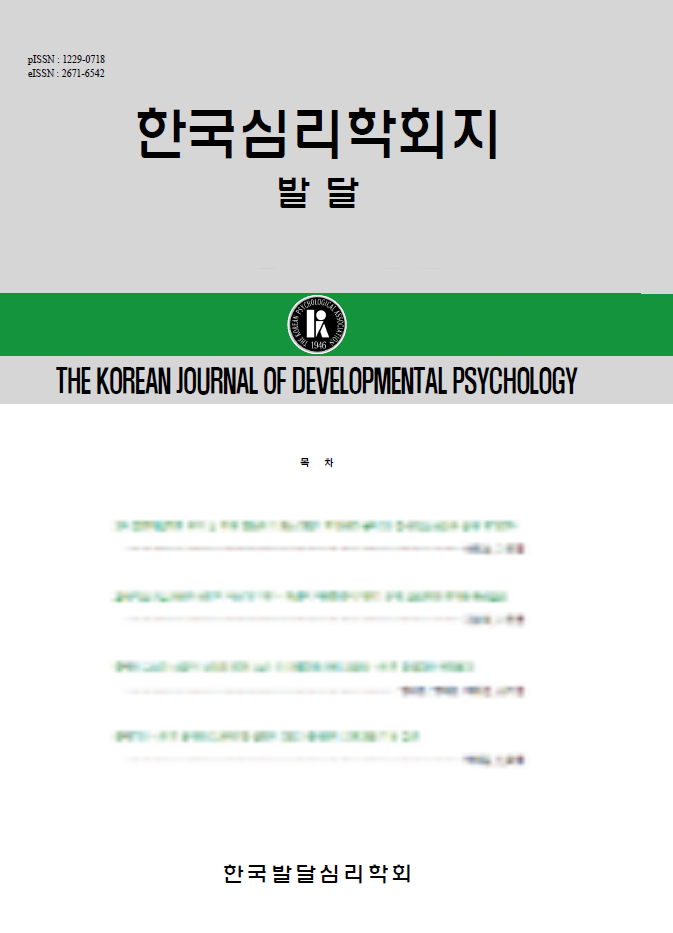open access
메뉴
open access
메뉴 ISSN : 1229-0718
ISSN : 1229-0718

We examined whether Korean 2- and 3-year-old children can use case markers to understand the meaning of Korean canonical (subject–object–verb; SOV) and noncanonical (object–subject–verb; OSV) word order in a transitive sentence. Side-by-side videos depicted the same caused motion events, both of which involved the same two characters but with the agent versus patient roles reversed. Along with the videos, children heard SOV sentences (e.g., Bear-nominative Rabbit-accusative is pushing.) or OSV sentences (e.g., Rabbit-accusative Bear-nominative is pushing.), both of which were marked with nominative and accusative case markers. Two-year-olds correctly understood only the canonical sentences (Experiment 1). In contrast, 3-year-olds understood both canonical and noncanonical sentences more accurately than predicted by chance (Experiment 2). These findings suggest that by the age of 3, Korean preschoolers can rely on case markers to understand sentence meaning.
강소영 (2008). 어순도치구문의 담화 기능 분석. 한국어의미학, 26, 1-20.
권도하, 정분선 (2000). 2-5세 아동의 조사 발달연구. 언어치료연구, 9, 139-164.
김수영 (1997). The early study of Korean morphology: A case study. 말-언어장애연구, 2, 89-119.
김유진 (2011). 대화에 나타나는 도치 구문에 관한 연구. 박사학위청구논문, 한양대학교.
배소영 (1997). 한국 아동의 문법형태소 습득연구: 조사 “가, 이, 는, 도, 를.” 말-언어장애 연구, 2, 27-42.
배소영, 이승환 (1996). 한국 아동의 이야기 산출 연구(1). 말-언어장애연구, 1, 34-67.
이순형 (2000). 한국아동이 초기에 획득한 문법적 형태소의 종류 및 획득시기. 아동학회지, 21(4), 51-68.
이영자, 이종숙, 이정욱 (1997). 보육시설 경험이 1, 2, 3세 아동의 구어 및 문어발달에미치는 영향. 한국영유아보육학, 10, 31-74.
이우열, 송현주 (2009). 형태론적 단서가 만 2세 아동의 새로운 동사학습에 미치는 영향. 한국심리학회지: 발달, 22(4), 111-123.
이윤하, 송현주 (2010). 한국 아동의 조사를 이용한 새로운 명사 학습. 한국심리학회지:발달, 23(1), 103-117.
이우열, 김민주, 송현주 (2013). 한국 아동의문장 구조 정보를 활용한 문장 이해 능력의 발달. 한국심리학회지: 발달, 26(4), 125-139.
이은경 (1999). 2~4세 유아의 격조사 발달에대한 연구. 언어치료 연구, 8, 131-153.
조명한 (1982). 한국 아동의 언어획득 연구: 책략모형. 서울: 서울대학교 출판부.
최영은 (2010). 한국어 복합 동사 습득 기제연구. 한국심리학회지: 발달, 23(3), 125-139.
황민아, 안혜진 (2002). 아동과 성인의 문장이해에서 의미, 조사, 어순단서의 활용 양상. 인간발달연구, 9(2), 39-54.
Dittmar, M., Abbot-Smith, K., Lieven, E., &Tomasello, M. (2008). Young German children’s early syntactic competence: A preferential looking study. Developmental Science, 11, 575-582.
Dryer, M. S. (2005). Order of subject, object, and verb. In M. Haspelmath, M. S. Dryer, D. Gil, & B. Comrie (Eds.), The world atlas of language structures(pp.330-333). Oxford: Oxford University Press.
Franck, J., Millotte, S., Posada, A., & Rizzi, L.(2013). Abstract knowledge of word order by 19 months: An eye-tracking study. Applied Psycholinguistics, 34, 323-336.
Fisher, C., Gertner, Y., Scott, R. M., & Yuan,S. (2010). Syntactic bootstrapping. Wiley Interdisciplinary Reviews: Cognitive Science, 1, 143-149.
Ganea, A., & Saylor, M. (2007). Infants' use of shared linguistic information to clarify ambiguous requests. Child Development, 78, 493-502.
Gertner, Y., & Fisher, C. (2012). Predicted errors in children’s early sentence comprehension. Cognition, 124, 85-94.
Gertner, Y., Fisher, C., & Eisengart, J. B. (2006). Learning words and rules: Abstract knowledge of word order in early sentence comprehension. Psychological Science, 17, 684-691.
Gleitman, L. R. (1990). The structural sources of verb meanings. Language Acquisition, 1, 3-55.
Goldin-Meadow, S. (2003). The resilience of language: What gesture creation in deaf children can tell us about how all children learn language. In J. Werker, H. Wellman (Eds.), The Essays in Developmental Psychology series. New York: Psychology Press.
Golinkoff, R. M., Hirsh-Pasek, K., Cauley, K. M.,& Gordon, L. (1987). The eyes have it:Lexical and syntactic comprehension in a new paradigm. Journal of Child Language, 14, 23-45.
Golinkoff, R. M., & Kerr, J. L. (1978). Infants'perceptions of semantically-defined action role changes in filmed events. Merrill-Palmer Quarterly, 24, 53-61.
Hartshorne, J. K., Nappa, R., & Snedeker, J.(2015). Development of the first-mention bias. Journal of Child Language, 42, 423-446.
Hawkins, J. A. (1983). Word Order Universals. New York: Academic Press.
Hirsh-Pasek, K., & Golinkoff, R. M. (1996). The intermodal preferential looking paradigm: A window onto emerging language comprehension. In D. McDaniel, C. McKee, &H. S. Cairns (Eds.), Methods for assessing children’s syntax. Language, speech and communication (pp.105-124). Cambridge, MA:The MIT Press.
Ibbotson, P., Theakston, A., Lieven, E., & Tomasello, M. (2011). The role of pronoun frames in early comprehension of transitive constructions in English. Language Learning and Development, 7, 24-39.
Kim, S., O’Grady, W., & Cho, S. (1995). The acquisition of case and word order in Korean:A note on the role of context. Language Research, 3, 687-695.
Lidz, J., Waxman, S., & Freedman, J. (2003). What infants know about syntax but couldn't have learned: Experimental evidence for syntactic structure at 18 months. Cognition, 89, 295-303.
Luo, Y., & Baillargeon, R. (2005). Can a self-propelled box have a goal? Psychological reasoning in 5-month-old infants. Psychological Science, 16, 601-608.
Mandler, J. M. (2004). The foundations of mind:Origins of conceptual thought. New York: Oxford University Press.
Naigles, L. R. (1990). Children use syntax to learn verb meanings. Journal of Child Language, 17, 357-374.
No, G. (2009). Acquisition of case markers and grammatical functions. In C. Lee, G. Simpson & Y. Kim (Eds.), The Handbook of East Asian Psycholinguistics: Korean (Vol. 3, pp.50-62). London: Cambridge University Press.
Otsu, Y. (1994). Early acquisition of scrambling in Japanese. Language Acquisition Studies in Generative Grammar, 8, 253-264.
Pyykkönen, P., Matthews, D., and Järvikivi, J. (2010). Three-year-olds are sensitive to semantic prominence during online language comprehension: a visual world study of pronoun resolution. Language and Cognitive Process. 25, 115-129.
Seidl, A., Hollich, G., & Jusczyk, P. W. (2003). Early understanding of subject and object wh-questions. Infancy, 4, 423-436.
Song, H., & Fisher, C. (2005). Who's “she”? Discourse prominence influences preschoolers'comprehension of pronouns. Journal of Memory and Language, 52, 29-57.
Song, H., & Fisher, C. (2007). Discourse prominence effects on 2.5-year-old children's interpretation of pronouns. Lingua, 117, 1959-1987.
Yuan, S., Fisher, C., & Snedeker, J. (2012). Counting the nouns: Simple structural cues to verb meaning. Child Development, 83, 1382-1399.
